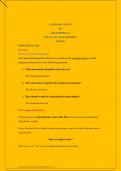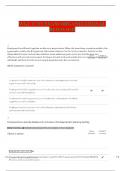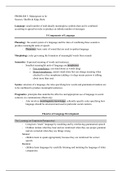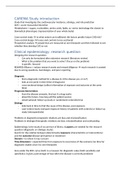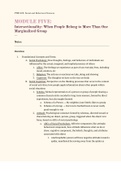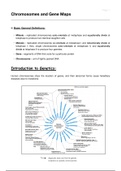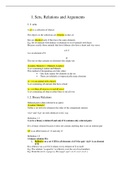2023
,1 The Labour Market Basics
1.1 Definitions
We look at three leading actors: firms, workers and governments (the first
two act in ways that maximize their well-being).
Labour Supply Curve Adding up all the decisions of millions of workers
generates labour supply. This includes numbers of people seeking work
and quantity/quality of skills.
Labour Demand Curve Adding up all the decisions of millions of em-
ployers generates labour demand.
Derived Demand Demand for a good or service that results from the de-
mand of another good or service e.g. labour is a derived demand result-
ing from firm’s primary demand for customers.
Equilibrium demand = supply
Excess demand for labour drives wages up.
Excess supply of labour drives wages down.
Government changes the equilibrium attained by correcting it with
regards to equality, ethnicity, tax, legislation etc. Po
Positive Statements Facts
Normative Statements Judgement
1.2 Trans-Alaskan Pipeline
Pipeline was built, and demand increased for labour, increasing
wages and increasing employment in neighboring towns.
This shows the classical theory at work.
Theory is not always representative, as the cutting-edge nature of the
project may have attracted engineers at a lower wage than those of-
fered by mundane projects.
1.3 Regression Analysis
If mean log wage between two occupations is 0.051, we can say there
is around 5.1% wage difference between the two (small ∆ in logs
mimics % changes)
We use logs to interpret changes in quantity as a percentage
change in wage.
β can be interpreted as giving the % change in earnings resulting
from one more year of education.
We use controls such as ability, IQ, parental income etc. as β on its
own rarely represents the full causal effect of schooling on wages.
From 1900-1990, there has been over 100% change in wages (↑ by
factor of four)
,1.4 Changes in the US Labour Markets over
time
Growth in productivity underlines a lot of this increase in growth of earnings
with technology being the key driver (↑ by factor of six).
Decline in work hours has been very steep (especially for manufactur-
ing workers)
Male labour force participation hasn’t budged but women’s has in-
creased massively
Union membership has reduced significantly
Greatest pikes in unemployment come in the 30s with Great De-
pression, spikes used to be massive but have moderated recently
In 1900, more than 70% of workers were manual or farmers, how-
ever, now over 50% are white collar workers.
Youth labour force participation has declined massively.
2 Labour Supply
2.1 Neo-Classical Model of Labour-Leisure
Choice
The economic model of labour-leisure choices isolates the person’s wage
rate and income as key variables that guide the allocation of time.
Utility function U ( C , L ) is a function of consumption and leisure:
It is a measure of satisfaction
The higher the U, the happier the person is
Indifference curves are the locus of points that
generate a particular level of utility:
Downward sloping (trade-off between C
and L)
Convex (opportunity costs increase)
Do not intersect (transitivity)
Higher indifference curve = higher utility
Looks different for different people based
on preferences
A utility function can be represented graphi-
cally as a family of ICs (concave)
Marginal Utility of Leisure ( M U L ¿ Change in utility from an additional
hour devoted to leisure activities, holding amount of goods consumed con-
stant
Marginal Utility of Consumption ( M U C ¿ Change in utility from an ad-
ditional hour devoted to consumption activities, holding amount of leisure
activities constant
, ∆ C −M U L
The slope of the indifference curve is = marginal rate of
∆L M UC
substitution
Steeper IC increased MRS (requires more C to convince someone
to give up L)
2.2 The Budget Constraint
Budget Constraint worker’s opportunity set, indicating all of the C-L
combinations the worker can afford.
Income and time are both constraints in one’s ability to consume goods
and leisure
Non-Labour Income V Hours Worked h Hourly Wage Rate w
Total Time T Leisure L
Equations:
C=wh+V
T =h+ L
C=w ( T −L ) +V
Slope is −w each hour of leisure some-
one is willing to give up, allows her to buy $
w additional goods.
Endowment point E if T =L, she can still
purchase $V goods.
Budget line represents total amount of
available income for each level of working
hours.
Assumption: A person chooses the combination of C and L that maximizes
her utility
P Interior Solution
E∧F Corner Solutions
M UL
At P (interior solution), =w
M UC
P> A (Utility wise) optimal consumption is
where the indifference curve is tangent to
the budget constraint

